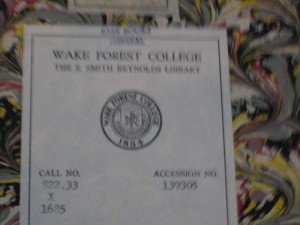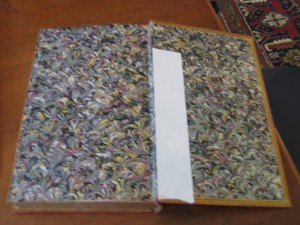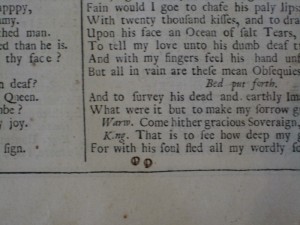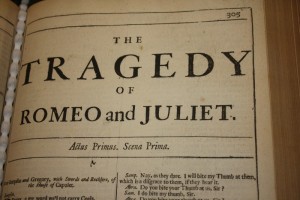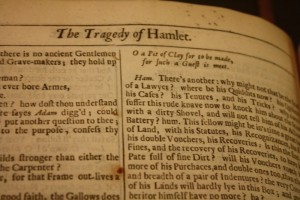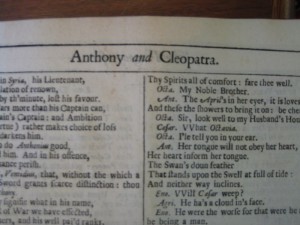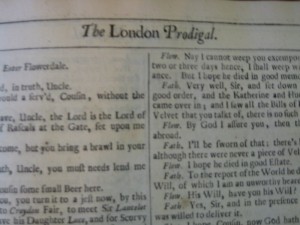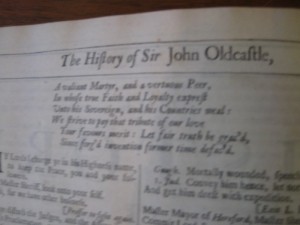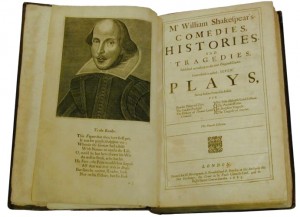Although the First Folio, published in 1623, is considered the most important book in English history; it is no doubt that the Fourth Folio also had a great impact and was momentous in the legacy of William Shakespeare. The fourth folio of Shakespeare was published in 1685. The book is in excellent condition and is a great collection for our library here at Wake Forest University in Winston Salem, NC.
This rare and marvelous folio was printed by H. Herringman, E. Brewster, R. Chiswell, and R. Bently in 1685. It contains some of Shakespeare’s most well-renowned plays like Romeo and Juliet, Hamlet, Julius Ceasar, and others. It was printed 60 years after the first folio. It has a portrait for Shakespeare engraved on the first page of the book. This book is rare because it is one of the few collected and printed editions of Shakespeare’s plays. During this time, plays were not considered important, and were to be “performed and attended, not read (Bauman Rare Books).” The fourth edition also contained additional 7 plays that were also in the third edition. However, this new folio was more modernized texts and designs. It became very popular and was the framework for the 1709 edition.
William Jackson states that the “[Shakespeare] folios are the most important works in the English language.”
The front cover is made of red, wooden material with a strong binding on hand-made (mold-made)pressed paper. The inside cover is modified with a colorful design.
The Chain lines are vertical and there is a watermark on the front page. There is also a label on the front indicating that this is a collection of Wake Forest University.
This version of the 4th Folio has a very complex signature collection. The format is set in alphabet, however, there are some letters missing as we scroll through. There are also few misprints, for which some of the pictures are presented.
In this misprint, the pp has been circled over with a pen. The “oo” is missing in the signing of the second part of the pagnation of the codex.
The above shows another misprint. Where as in the third part of the pagnation, of triple alphabet letters, there was to be “H h H,” the misprint shows a “H h j.”
Besides some of the misprints and the chaotic signature collection of this rare Fourth Folio, we find some of the most notable works that have shaped the legacy of William Shakespeare.
The font type used in this Folio is mostly Roman with some italicized texts in the Titles.
With the tragedies, we also find other notable works.
It is no doubt that the addition of this magnificent Fourth Folio to the Wake Forest College library is one of the rarest and most prized. It is truly a privilege and honor to go through such a fine piece of history in the rare books collection here at Z. Smith Reynold Library.
Full Title of the Book is transcribed below.
Mr. William Shakespeare’s Comedies, histories and tragedies: published according to the true original copies. Unto which is added seven plays, never before printed in folio: viz. Pericles Prince of Tyre, The London prodigal, The history of Thomas Lord Cromwel, Sir John Oldcastle, Lord Cobham, The Puritan widow, A Yorkshire tragedy, The tragedy of Locrine. The Fourth ed. London, printed for H. Herringman, and R. Bentley, 1685.
This is a collection of Shakespeare’s work, which was printed by H. Herringman, E. Brewster, R. Chiswell, and R. Bently in 1685. It contains some of Shakespeare’s most well-renowned plays like Romeo and Juliet, Hamlet, Julius Ceasar, and others. It was printed 60 years after the first folio. It has a portrait for Shakespeare engraved on the first page of the book. This book is rare because it is one of the few collected and printed editions of Shakespeare’s plays. During this time, plays were not considered important, and were to be “performed and attended, not read (Bauman Rare Books).” The fourth edition also contained additional 7 plays that were also in the third edition. However, this new folio was more modernized texts and designs. It became very popular and was the framework for the 1709 edition.
William Jackson states that the “[Shakespeare] folios are the most important works in the English language.”
Works Cited:
Company, Manhattan Rare Books. “The 1685 Fourth Folio of William Shakespeare.” The 1685 Fourth Folio of William Shakespeare. The Manhattan Rare Books Company, Web. 09 May 2015.



